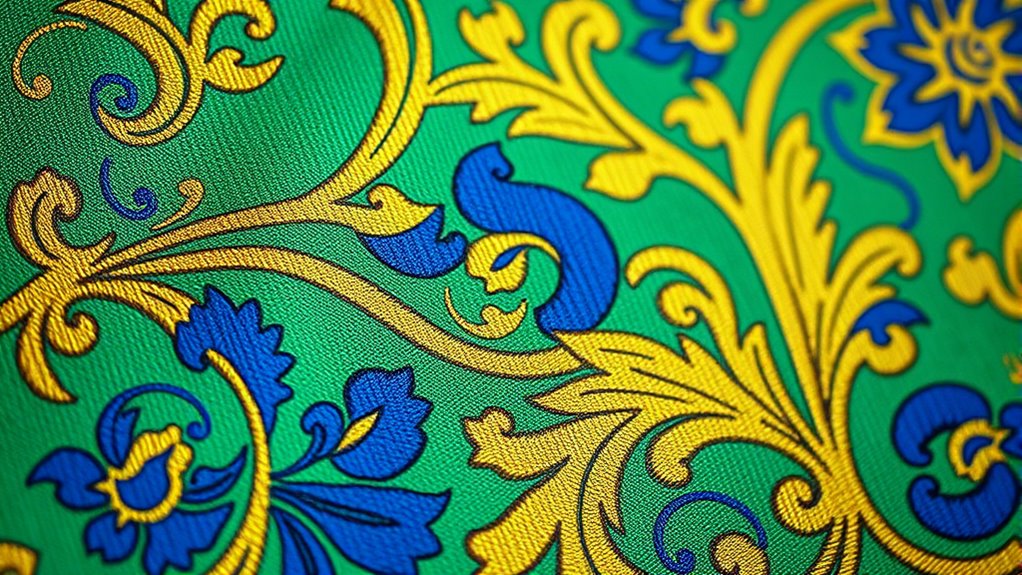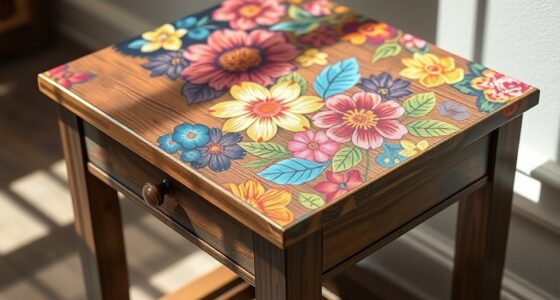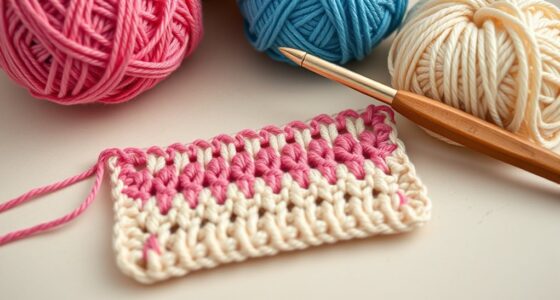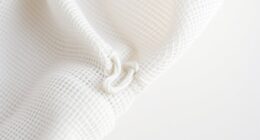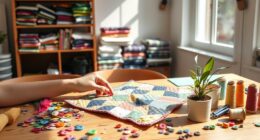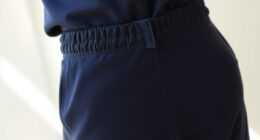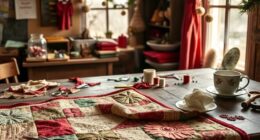Jacquard weaves use punched cards or digital controls to create highly complex patterns by individually directing warp threads. This technology allows you to produce intricate designs like floral motifs, geometric shapes, and detailed texture effects with precision, which would be nearly impossible by hand. By understanding how the loom’s automation manages each thread’s movement, you’ll see how beautiful and sophisticated woven textiles are made. Keep exploring to uncover the detailed process behind these remarkable patterns.
Key Takeaways
- Jacquard weaves create intricate patterns by controlling individual warp threads with punched cards or digital commands.
- Reading complex patterns involves understanding how each punched hole or digital signal lifts specific threads.
- Patterns are typically structured with a key or legend indicating thread movements corresponding to design elements.
- Recognizing motifs and motifs repetition helps decipher the design layout within the pattern.
- Detailed Jacquard patterns often feature precise, sharp motifs that reflect the controlled, thread-by-thread weaving process.

Have you ever wondered how intricate patterns are woven into fabric with such precision? The secret lies in advanced loom technology, particularly Jacquard looms, which revolutionized the way textile patterns are created. Unlike traditional looms that require manual intervention to produce complex designs, Jacquard looms use a sophisticated system of punched cards or digital controls to automate the weaving process. This innovation allows you to produce highly detailed textile patterns that would be impossible to craft by hand or with simpler machinery. When you look closely at a fabric made with Jacquard weaving, you’ll notice how the patterns are so precisely rendered, with sharp lines and complex motifs that seem almost alive. This precision is a direct result of loom technology that can control hundreds, sometimes thousands, of individual warp threads simultaneously.
Understanding how Jacquard weaving works helps you appreciate the complexity behind these textile patterns. Each punched card or digital command corresponds to a specific movement of the warp threads, enabling the loom to lift certain threads while leaving others in place. This creates a weaving path that forms intricate designs woven directly into the fabric. As a result, you can produce everything from ornate floral motifs to geometric abstractions with remarkable fidelity. The beauty of Jacquard technology is that it offers flexibility—allowing you to switch between patterns easily, making it ideal for both mass production and bespoke textiles. When you engage with textiles crafted on Jacquard looms, you’re witnessing a marriage of engineering and artistry that has elevated textile design from simple woven fabric to a canvas for complex visual storytelling.
Furthermore, Jacquard weaving opens up a world of creative possibilities. You can incorporate multiple colors, textures, and patterns into a single piece, creating textiles that are rich in detail and depth. This capability has influenced countless industries, from high fashion to interior design, where textile patterns serve as statement pieces. As you explore different fabrics, you’ll notice how the loom technology allows for precise control over every thread, ensuring consistent quality across large runs or unique one-of-a-kind pieces. This innovative loom design is a prime example of technological progress transforming traditional crafts. The mastery of weaving complex textile patterns using Jacquard technology exemplifies how innovation in loom design continues to push the boundaries of textile artistry. It transforms weaving from a manual craft into a sophisticated art form, where the complexity of patterns is no longer a challenge but a [TESTAMENT] to the power of technological progress.
Frequently Asked Questions
How Do Jacquard Weaves Differ From Other Weaving Techniques?
Jacquard weaves differ from other techniques because they allow you to create highly detailed and intricate patterns through automation integration. Unlike simple weaves, Jacquard machines control individual warp threads, enabling you to produce complex designs with precision. This advanced control makes your patterns more elaborate and textured, giving you greater flexibility in design. Fundamentally, Jacquard weaving elevates your work by combining pattern complexity with modern automation for stunning textile creations.
What Materials Are Best Suited for Jacquard Weaving?
You should choose materials with good fiber durability and color fastness for jacquard weaving. Fibers like silk, cotton, wool, and synthetic options such as polyester work well because they withstand intricate patterns and repeated washing. These materials maintain their appearance and strength over time, ensuring your woven designs stay vibrant and durable. Selecting the right fibers is essential for achieving high-quality, long-lasting jacquard fabrics.
Can Beginners Learn to Create Complex Jacquard Patterns?
Creating complex jacquard patterns is like building a detailed puzzle—you can do it, but it takes patience. As a beginner, you’ll develop your pattern design skills step by step, mastering the basics first. With practice, you’ll gain access to the ability to craft intricate designs. Stay persistent, learn from each project, and watch your skill development grow, turning you into a confident jacquard pattern creator over time.
How Does the Jacquard Loom Operate Mechanically?
You might wonder how a jacquard loom works mechanically. It operates with a punch card mechanism that controls each individual warp, allowing precise pattern creation. As the loom advances, the punch cards selectively lift or lower warp threads, enabling complex designs. This system gives you direct control over each thread, making intricate patterns possible and automating the process while maintaining detailed craftsmanship.
What Are Common Challenges When Working With Jacquard Weaves?
Imagine steering a tangled web of threads—working with Jacquard weaves can feel just like that. Pattern complexity often challenges you, making it hard to keep designs precise. Thread tension is another hurdle; uneven tension causes distortions and inconsistencies. You might struggle to maintain clarity in intricate patterns or keep tension balanced across the loom. Patience and careful adjustments become essential to produce flawless, detailed textiles.
Conclusion
Now that you know how Jacquard weaves bring intricate patterns to life, imagine the thousands of tiny hooks working together seamlessly. Did you know that a single Jacquard loom can control over 50,000 individual threads? That’s like orchestrating a symphony of textiles! With this knowledge, you’ll appreciate the incredible craftsmanship behind complex fabrics, making each woven masterpiece all the more fascinating. Keep exploring, and you’ll see patterns everywhere with new eyes.
